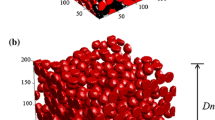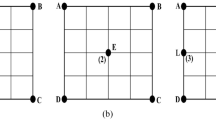Abstract
The effect of the anode pore size is numerically investigated with the aids of artificial solid oxide fuel cell (SOFC) microstructure information. The standalone effect of the pore size is impossible to be realized by the experimental approach. Additionally, the complete real microstructure information is also limited in the open literature as it required sub-micron 3D imaging equipment. The dusty-gas model is implemented into the developed quasi-3D SOFC model for the gas diffusion in the anode. The model with real microstructure information is successfully validated. The actual anode pore radius of 0.283 μm is artificially replaced with a radius of 0.025, 0.050, 0.250, 0.500, and 2.500 μm. Decrement of area-specific reactant (ASR) for the anode concentration is found with the increment of pore radius. Also, such increment promotes a small increment of ASRs for the anode activation and the anode ohmic loss.
Access this chapter
Tax calculation will be finalised at checkout
Purchases are for personal use only
Similar content being viewed by others
References
Ab Rahman, M., et al.: Development of high-performance anode/electrolyte/cathode micro-tubular solid oxide fuel cell via phase inversion-based co-extrusion/co-sintering technique. J. Power Sources 467, 228345 (2020)
Ren, C., Zhang, Y., Xu, Q., Tian, T., Chen, F.: Effect of non-solvent from the phase inversion method on the morphology and performance of the anode supported microtubular solid oxide fuel cells. Int. J. Hydrogen Energy 45, 6926–6933 (2020)
Rabuni, M.F., Vatcharasuwan, N., Li, T., Li, K.: High performance micro-monolithic reversible solid oxide electrochemical reactor. J. Power Sources, 458, 228026 (2020)
Liu, Y., Jia, L., Li, J., Chi, B., Pu, J., Li, J.: High-performance Ni in-situ exsolved Ba(Ce0.9Y0.1)0.8Ni0.2O3-δ/Gd0.1Ce0.9O1.95 composite anode for SOFC with long-term stability in methane fuel. Compos. Part B Eng. 193, 108033 (2020)
Price, R., Grolig, J.G., Mai, A., Irvine, J.T.S.: Evaluating sulfur-tolerance of metal/Ce0.80Gd0.20O1.90 co-impregnated La0.20Sr0.25Ca0.45TiO3 anodes for solid oxide fuel cells. Solid State Ionics, 347, 115254 (2020)
Shahid, M., He, C., Sankarasubramanian, S., Ramani, V., Basu, S.: Enhanced methane electrooxidation by ceria and nickel oxide impregnated perovskite anodes in solid oxide fuel cells. Int. J. Hydrogen Energy 45, 11287–11296 (2020)
Tan, W.C., Iwai, H., Kishimoto, M., Brus, G., Szmyd, J.S., Yoshida, H.: Numerical analysis on effect of aspect ratio of planar solid oxide fuel cell fueled with decomposed ammonia. J. Power Sources 384, 367–378 (2018)
Tan, W.C., Iwai, H., Kishimoto, M., Yoshida, H.: Quasi-three-dimensional numerical simulation of a solid oxide fuel cell short stack: effects of flow configurations including air-flow alternation. J. Power Sources 400, 135–146 (2018)
Tan, W.C., Iwai, H., Kishimoto, M., Yoshida, H.: Implementation of multi-component dusty-gas model for species transport in quasi-three-dimensional numerical analysis of solid oxide fuel cell. Part II: direct ammonia fuel. IOP Conf. Ser. Mater. Sci. Eng. 670, 012022 (2019)
Brus, G., et al.: Combining structural, electrochemical, and numerical studies to investigate the relation between microstructure and the stack performance. J. Appl. Electrochem. 47(9), 979–989 (2017). https://doi.org/10.1007/s10800-017-1099-5
Brus, G., Iwai, H., Otani, Y., Saito, M., Yoshida, H., Szmyd, J.S.: Local evolution of triple phase boundary in solid oxide fuel cell stack after long-term operation. Fuel Cells. 15, 545–548 (2015)
Bhattacharyya, D., Rengaswamy, R., Finnerty, C.: Isothermal models for anode-supported tubular solid oxide fuel cells. Chem. Eng. Sci. 62, 4250–4267 (2007)
Kanno, D., Shikazono, N., Takagi, N., Matsuzaki, K., Kasagi, N.: Evaluation of SOFC anode polarization simulation using three-dimensional microstructures reconstructed by FIB tomography. Electrochim. Acta. 56, 4015–4021 (2011)
Nelson, G.J., et al.: Three-dimensional microstructural changes in the Ni–YSZ solid oxide fuel cell anode during operation. Acta Mater. 60, 3491–3500 (2012)
Huang, X., Reimert, R.: Kinetics of steam reforming of ethane on Ni/YSZ (yttria-stabilised zirconia) catalyst. Fuel 106, 380–387 (2013)
Yoon, K.J., et al.: Gas transport in hydrogen electrode of solid oxide regenerative fuel cells for power generation and hydrogen production. Int. J. Hydrogen Energy 39, 3868–3878 (2014)
Kishimoto, M., Lomberg, M., Ruiz-Trejo, E., Brandon, N.P.: Enhanced triple-phase boundary density in infiltrated electrodes for solid oxide fuel cells demonstrated by high-resolution tomography. J. Power Sources 266, 291–295 (2014)
Brus, G., Miyawaki, K., Iwai, H., Saito, M., Yoshida, H.: Tortuosity of an SOFC anode estimated from saturation currents and a mass transport model in comparison with a real micro-structure. Solid State Ionics 265, 13–21 (2014)
Shimada, H., Suzuki, T., Yamaguchi, T., Sumi, H., Hamamoto, K., Fujishiro, Y.: Challenge for lowering concentration polarization in solid oxide fuel cells. J. Power Sources 302, 53–60 (2016)
Nakajo, A., et al.: Accessible triple-phase boundary length: a performance metric to account for transport pathways in heterogeneous electrochemical materials. J. Power Sources, 325, 786–800 (2016)
Lu, X., et al.: Correlation between triple phase boundary and the microstructure of Solid Oxide Fuel Cell anodes: the role of composition, porosity and Ni densification. J. Power Sources 365, 210–219 (2017)
Yan, Z., He, A., Hara, S., Shikazono, N.: Modeling of solid oxide fuel cell (SOFC) electrodes from fabrication to operation: correlations between microstructures and electrochemical performances. Energy Convers. Manag. 190, 1–13 (2019)
Chen, B., Xu, H., Ni, M.: Modelling of finger-like channelled anode support for SOFCs application. Sci. Bull. 61(17), 1324–1332 (2016). https://doi.org/10.1007/s11434-016-1131-x
Fuller, E.N., Schettler, P.D., Giddings, J.C.: New method for prediction of binary gas-phase diffusion coefficients. Ind. Eng. Chem. 58, 18–27 (1966)
Author information
Authors and Affiliations
Corresponding author
Editor information
Editors and Affiliations
Rights and permissions
Copyright information
© 2022 The Author(s), under exclusive license to Springer Nature Singapore Pte Ltd.
About this paper
Cite this paper
Tan, W.C., Lim, E.A., Cheng, E.M., Tan, W.H. (2022). Numerical Analysis of the Effect of Pore Size Toward the Performance of Solid Oxide Fuel Cell. In: Mahyuddin, N.M., Mat Noor, N.R., Mat Sakim, H.A. (eds) Proceedings of the 11th International Conference on Robotics, Vision, Signal Processing and Power Applications. Lecture Notes in Electrical Engineering, vol 829. Springer, Singapore. https://doi.org/10.1007/978-981-16-8129-5_24
Download citation
DOI: https://doi.org/10.1007/978-981-16-8129-5_24
Published:
Publisher Name: Springer, Singapore
Print ISBN: 978-981-16-8128-8
Online ISBN: 978-981-16-8129-5
eBook Packages: Intelligent Technologies and RoboticsIntelligent Technologies and Robotics (R0)




